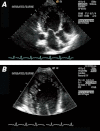Multiple left ventricular thrombi in a patient with left ventricular noncompaction
- PMID: 22949776
- PMCID: PMC3423290
Multiple left ventricular thrombi in a patient with left ventricular noncompaction
Abstract
The major clinical features of myocardial noncompaction are heart failure, arrhythmias, and thromboembolic events. Prominent myocardial trabeculae and deep recesses characteristic of myocardial noncompaction can cause stagnant blood flow and the formation of left ventricular clots. We describe the case of a 62-year-old woman who presented with symptoms of heart failure secondary to left ventricular noncompaction. Transthoracic and transesophageal echocardiography revealed multiple left ventricular thrombi, which had formed despite the patient's long-term therapy with aspirin. Anticoagulative therapy should be considered for patients with myocardial noncompaction who also have risk factors for thromboembolism, such as atrial fibrillation, a history of systemic embolism, or severe left ventricular systolic dysfunction. However, chronic antiplatelet therapy may not sufficiently prevent clot formation in patients who have myocardial noncompaction and severe left ventricular systolic dysfunction.
Keywords: Cardiomy-opathies/complications/diagnosis/drug therapy; echocardiography; heart ventricles/abnormalities; myocardium/pathology; ventricular dysfunction, left/ultrasonography.
Figures






References
-
- Stollberger C, Finsterer J. Left ventricular hypertrabeculation/noncompaction. J Am Soc Echocardiogr 2004;17(1):91–100. - PubMed
-
- Eilen D, Peterson N, Karkut C, Movahed A. Isolated non-compaction of the left ventricular myocardium: a case report and literature review. Echocardiography 2008;25(7):755–61. - PubMed
-
- Tigen K, Karaahmet T, Gurel E, Cevik C, Basaran Y. Biventricular noncompaction: a case report. Echocardiography 2008;25(9):993–6. - PubMed
-
- Oechslin EN, Attenhofer Jost CH, Rojas JR, Kaufmann PA, Jenni R. Long-term follow-up of 34 adults with isolated left ventricular noncompaction: a distinct cardiomyopathy with poor prognosis. J Am Coll Cardiol 2000;36(2):493–500. - PubMed
-
- Ritter M, Oechslin E, Sutsch G, Attenhofer C, Schneider J, Jenni R. Isolated noncompaction of the myocardium in adults. Mayo Clin Proc 1997;72(1):26–31. - PubMed
Publication types
MeSH terms
Substances
LinkOut - more resources
Full Text Sources
Medical
